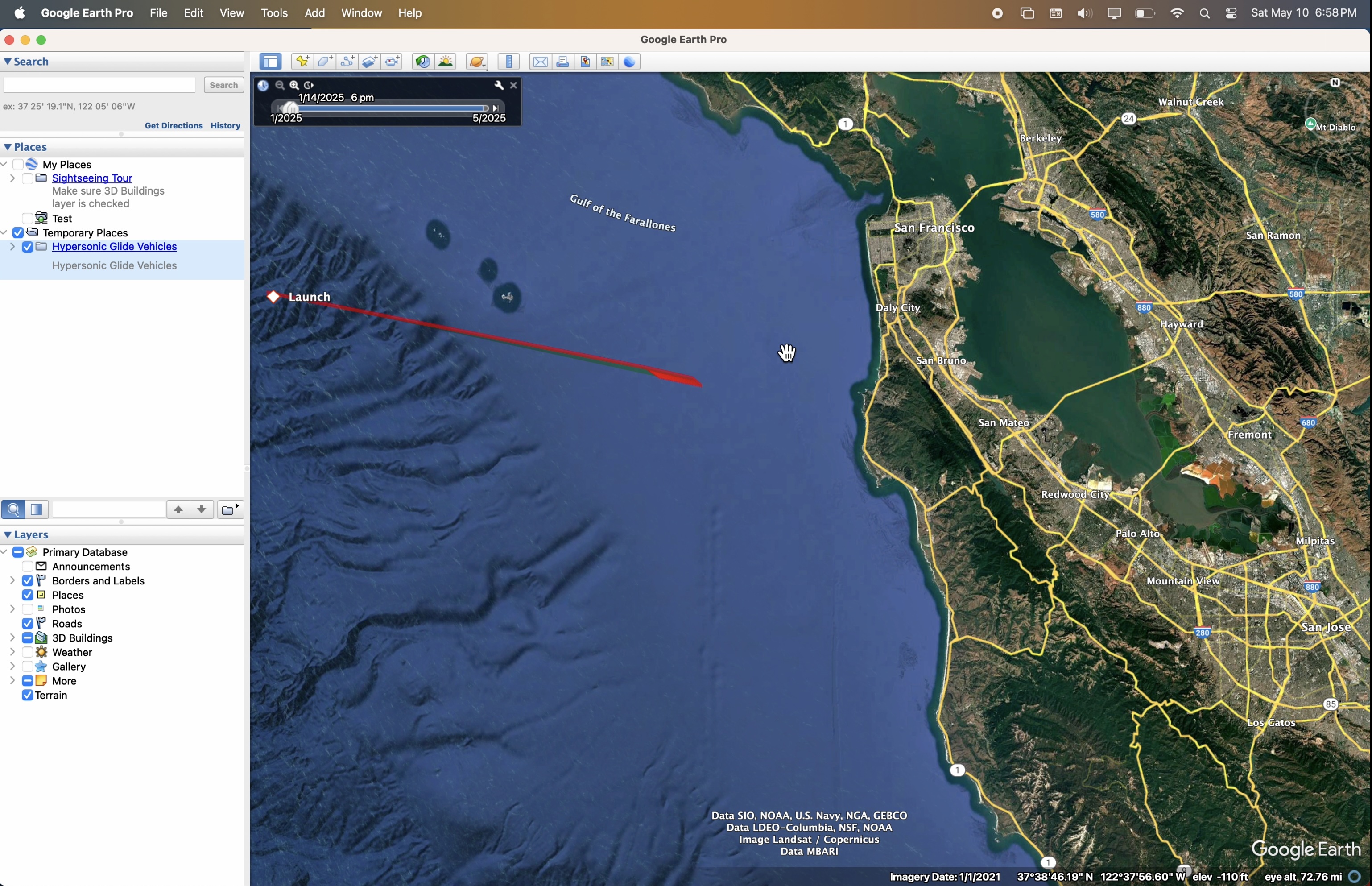Found attachment of size 1580232.

Sat, 10 May 2025 19:17:48 -0700 Andy from private IP, post #10839148 /all Working on a complicated programming project today. This is responsive to a broad agency announcement from DARPA and relates to hypersonic glide vehicles (HGVs), which are an emerging threat from Russia and China. I call my design Infinity Stone. It's intended to compute the tracks and targets of HGVs against a blue team target list with weights using Bayes's Theorem and A.I. inference. I wrote a full proposal on my website, but today was the first day of work on the proof of concept. After one day, I have a real-time updated track in Google Earth Pro that shows the launch point, apogee, and impact point of a simulated HGV. The start of something great. https://www.raellic.com/images/test.mov https://www.raellic.com/programs/Infinity-Stone/Infinity-Stone-1.pdf #Politics #Programming #Technology Sat, 10 May 2025 19:18:41 -0700 Andy from private IP Reply #17563645 In this simulation, a submarine launches a nuclear-tipped HGV at my office. Ha. Sat, 10 May 2025 21:15:01 -0700 whiteguyinchina from private IP Reply #11183589 👍 👍 Are you trying to make me feel dumb? You already are the greatest lawyer programmer in the world. What else do you want? Sun, 11 May 2025 09:36:36 -0700 phosita from private IP Reply #19965025 👍 What's known about the ability of these HGVs to maneuver? I suppose they must not be purely ballistic, otherwise you would find yourself working on something that's been a solved problem since the 50s. I'll also go out on a limb and posit that the point of this is so a defender can launch non-fast non-hypersonic air defense countermeasures with the idea of putting those sluggish projectiles in a piece of sky through which the Rus intends his weapon to fly. Yes? Update: just read the proposal (such buzzword! many govspeak!) and yup, that seems to be what you're after. It also allows a defender to avoid launching any countermeasures having zero chance of effecting an intercept. Keep some in reserve and also keep their locations secret until launching them. So how do these Soviet weapons fly? You wrote of "extremely minor turning, change in speed, and other maneuvers" the HGVs can do. Just wondering how maneuverable these jobbies are. I suppose the maneuvers they do are by way of reaction controls rather than by aerodynamic control surfaces. Your proposal sounds like the weapons are detected with (terrestrial?) radar. Which has obvious limitations: radar can only see to its horizon. Now let's say the Konovalov is over the horizon with respect to terrestrial radar: fair chance, then, its weapon has already reached hypersonic speed before you can paint it. Time being of the essence, not optimal. It would be groovy if there were an AWACs available and able to share its sensor data with you. Also your proposal totally buries an excellent lede: you're calculating where the missile is going - fine - but you probably also have some ability to calculate its launch site, albeit less precisely. Presumably USN would love to know the location of a Soviet sub even within tens of miles. There's extant space-based lookdown sensor capability to detect ICBM launches. Probably it is turbo ultra double secret classified whether such an asset can detect an HGV launch, but if not and if you could get a feed of the sensor then that would be pretty leet. Also a question: are the HGVs totally autonomous once launched? Do they have any data link back to their launch (or other) site? If that's known then there are probably peeps interested in SIGINTing the emissions. With enough sensors you could attempt triangulation with ToF and wouldn't need to decode the signals' contents. Sun, 11 May 2025 09:51:45 -0700 phosita from private IP Reply #15305119 👍 How high can apogee really be when you're flying hypersonic at less than ~60 statute miles from a Soviet sub toward the Oracle mothership? Can't be very high, if your weapon does not have the capability to pull many Gs. Quite dastardly if you're relying on radar detection. Possibly trashy GOOG AI answer, but it tells us the radius of a 10g turn at 5000 kph is close to 20 km. All by way of saying there's probably tens of minutes of mathematica involved in figuring out, like, a minimum apogee for the HGV given its distance to target and assumed speed and ability to pull Gs. Which, in turn, will tell you something about how far a radar can be and still paint it. Anyhow. Going to wrench on my bicycle. Mon, 12 May 2025 03:23:29 -0700 Andy from private IP Reply #14070341 @phositaTest Truly, you have a dizzying intellect. These are great points and I will incorporate them into the system. The simulated sub launch off the coast of California is really a worst-case scenario. The HGV wouldn't get high enough to attain Mach 5 in the terminal phase. I'll address your other comments in a separate reply. Much appreciated!Replies require login.
@11183589 47.156.140.32 👍 @11183589 Andy 👍 @19965025 Andy 👍 @15305119 Andy 👍
